Like a precious “matryoshka” Russian doll, this garden encompasses many centuries of history: the English-style gardens contains 18th-century hornbeam galleries and a Renaissance nymphaeum with unexpected water features that enchanted Stendhal himself.
In the late 16th century, Pirro Visconti Borromeo improved his farm estate by adding a “villa di delizia” and commissioning the finest Lombard artists of the time, including Camillo Procaccini and Morazzone, to create an Italian-style garden dominated by a majestic Nymphaeum with rich décor and spectacular water features (the Palazzo delle acque) around the 16th-century palazzo (the “Riposteria”). The complex was later acquired by Count Visconti Borromeo Arese (responsible for the “Quarto nuovo” apartments), and, after him, by Marquis Litta, who in 1745 funded extension of the gardens to create an ideal setting for parties and receptions. Today as in the past, visitors arrive in the rustic courtyard and formal garden via the Mercury Rotunda. To the west, a hornbeam gallery connects the open-air theatre and the Garden of Hesperides, passing by the Triton Fountain. To the north is the Fountain of Galatea and an exedra featuring the Rape of Proserpine. Not far off, just past the foliage of a monumental Ginkgo biloba is a Garden of Medicinal Plants with its seasonal scents. In the 19th century, architect Luigi Canonica and botanist Linneo Tagliabue adapted a portion of the complex to new tastes for wilder-looking English-style gardens, planting more than 800 trees and 56 different species of shrub. The Litta family modified the nymphaeum’s facades, adding limestone concretions to harmonize the building and landscaped gardens. After a spell of ownership by the Weill Weiss family, in 1932 the Toselli family became owners and commissioned architect Giuseppe Tramajoni to restore the property. Since 1971, the site has belonged to the Municipality of Lainate, which has carried out major restorations and enhancement works.
Highlights
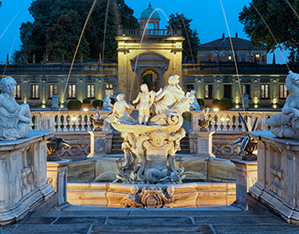
The Fountain of Galatea
Designed by architect and painter Giuseppe Levati for the Litta family, this majestic, multi-level fountain fires its jets into a basin decorated with numerous statues by Francesco and Donato Carabelli, including a standout veiled female figure, the Allegory of Silence.
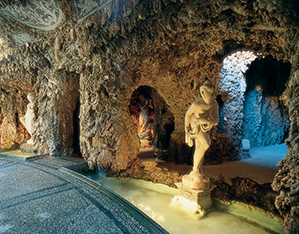
The Nymphaeum
Arranged around the Atrio dei Quattro Venti and the Galleria delle Romane, this extraordinary “cool house” was designed by Martino Bassi and fountain-maker Agostino Ramelli, with pebble, tuff rock and shell decorations by Camillo Procaccini and Francesco Brambilla the Younger. Restoration of the complex waterworks system in the 1990s breathed new life into the villa’s stunning and exceptional water features.
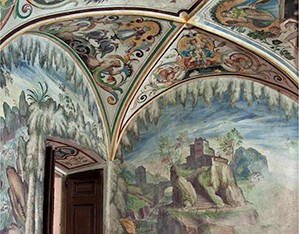
Sixteenth-century Palazzo
On the far side of a portico supported by double granite columns, the central portion of the villa boasts numerous frescoed rooms, including the Hall of Aeneas, the Hall of Hunting, and the Hall of Fire. Throughout, the Visconti family’s coats of arms alternate with St. Charles Borromeo’s motto of “Humilitas”.
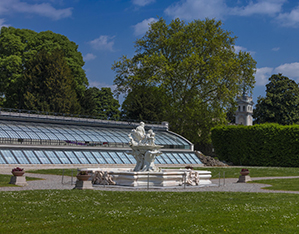
Greenhouses and Orchid Collection
Iron and glass greenhouses were built in the 19th century to house a fine collection of tropical plants, including orchids, pineapples, coffee and date palms. Meticulous restoration returned them to their original function after half a century of neglect. Today, they house over 2,000 orchids.
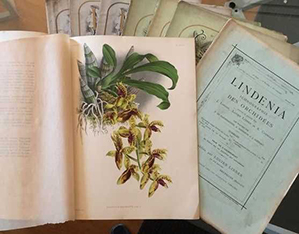
L'Iconographie des Orchidées
Seventeen volumes of Lindenia. Iconographie des orchidées , illustrated with 420 chromolithographic prints, are conserved in the villa’s corridor of statues. This work was printed in the late 1800s by Lucien Linden, son of famous botanist and explorer Jean Linden, to whom we owe the earliest detailed studies of the growing conditions of orchids in their natural habitat, and initial experiments to cultivate orchids in Europe.
 Villa Visconti Borromeo Litta
Contacts
Villa Visconti Borromeo Litta
Contacts
Contacts
Telephone:- +39 02 9374282
- +39 02 93598267
Address
Largo Vittorio Veneto, 12
20020, Lainate (MI)
 Villa Visconti Borromeo Litta
Opening times and prices
Villa Visconti Borromeo Litta
Opening times and prices
Opening hours
The historic park of the Villa (Public Park) is open every day from 8.30 am to 7 pm.
Month of May:
- Sunday 3 p.m. – 6 p.m. (guided tours start every 30 minutes; maximum 18 visitors per shift).
Strolling among the treasures of Villa Litta (duration 1h and 30 minutes): a guided tour through the Nymphaeum and the Historical Park to breathe the atmosphere of past eras. - Sunday 3.15 p.m. – 5 p.m. (limited entry)
Sixteenth- and eighteenth-century palaces (duration 45 min. approx.): free, unguided tour with the aid of QR codes - from Saturday, May 22: 5-6 pm (departure every 15 minutes; maximum 20 visitors per shift)
“Nymphaeum Hour: Appetite comes by visiting” (maximum stay inside the Nymphaeum: 1 h): free visit inside the Nymphaeum with the help of QR codes and explanations along the way. An opportunity to experience Villa Litta and the city of Lainate during Happy Hour: showing the ticket of the visit in bars / pubs agreement, visitors can take advantage of a discount on consumption.
Monday to Friday: closed
In case of bad weather the guided tours will still take place.
Pricing
For more information about rates, please consult the website of the Villa.
Access to the facility is limited and subject to availability. Entrance is by reservation only, even for categories that benefit from free admission.
- Booking
online
on the website of the Villa: by purchasing the ticket online you will be entitled to a 10% discount on purchases at the Bookshop; a reduction of 1.50 € on the entrance ticket to the Nymphaeum - Telephone booking: Monday to Wednesday from 10.00 a.m. to 12.30 p.m. at +39 02 9374282;
Payment can only be made by bank transfer. Other payment methods are not allowed
 Villa Visconti Borromeo Litta
How to get there
Villa Visconti Borromeo Litta
How to get there
Address
Largo Vittorio Veneto, 12
20020, Lainate (MI)
Latitude: 45.5714536
Longitude: 9.0243723
How to arrive by road
From the A8 Milano-Laghi motorway, exit at Lainate-Arese. Attention: from 23.00 on 29/06/2019 the access/exit ramps of the A8 Motorway (Entrance Direction Milan, Exit coming from Milan) have been permanently closed. Here are the alternative routes:
- From Lainate to Milan: the LAINATE entrance is definitively closed, access to the motorway is from via Mascagni passing through the Sifte Berti area.
- From Lainate to Varese-Como: the current access to the tollbooth is maintained;
- For those coming from Milan and must exit at Lainate: the LAINATE exit will be permanently closed, take the previous LAINATE-ARESE exit.
- For those coming from Varese/Como and need to exit at Lainate: the current exit is maintained.
For more information regarding the latest road changes
click here
.
S.S.33 del Sempione, follow the signs for Lainate when you reach the towns of Rho (then take the S.P. 101) or Nerviano (then take the S.P. 109).
S.S. 233 Varesina, follow the signs for Lainate at Garbagnate (then take the S.P. 109) or Saronno (then take the S.P. 101)
In Lainate follow the signs “CENTRO” or the tourist signs “VILLA BORROMEO VISCONTI LITTA”.
How to arrive by train
By train, the nearest stations to Lainate are Rho and Saronno. Then you have to take the bus to Lainate.
- Rho: departure from Piazza della Libertà – Railway Station (coach direction Saronno)
- Saronno: departure from Piazza I Maggio – Autostazione (bus direction Rho)
- For timetables consult the website.
How to arrive by bus
From the bus station Milano Lampugnano (MM1 – Red Line) take the direct bus to Lainate.
For timetables consult the website.
The nearest bus stop to Villa Litta is Piazza Matteotti.
 Villa Visconti Borromeo Litta
Services/Accessibility
Villa Visconti Borromeo Litta
Services/Accessibility
Services
Villa Visconti Borromeo Litta offers several types of guided tours
- daytime guided tours
- nocturnal guided tours
- guided tours in costume
Accessibility
The Villa is almost entirely accessible.
- The steps are covered with self-propelled platforms or can be circumvented from the side lawns.
- The gravel on the driveways presents a difficulty if you don’t have a companion.
- The buildings are equipped with an elevator so they are accessible in their entirety.
- The greenhouses are only accessible in the ground floor part. The basement is not wheelchair accessible.
 Villa Visconti Borromeo Litta
Private events
Villa Visconti Borromeo Litta
Private events
The Villa offers the possibility to organize many private events such as meetings, ceremonies, convivial meetings and wedding lunches, exhibitions and fashion shows. For further information please consult the website.
 Villa Visconti Borromeo Litta
Itineraries
Villa Visconti Borromeo Litta
Itineraries
You could find the garden in these itineraries
 Favorite saving result
Favorite saving result
 Warning!
Warning!
You've have to sign up or sign in to add this element to your favorites.
